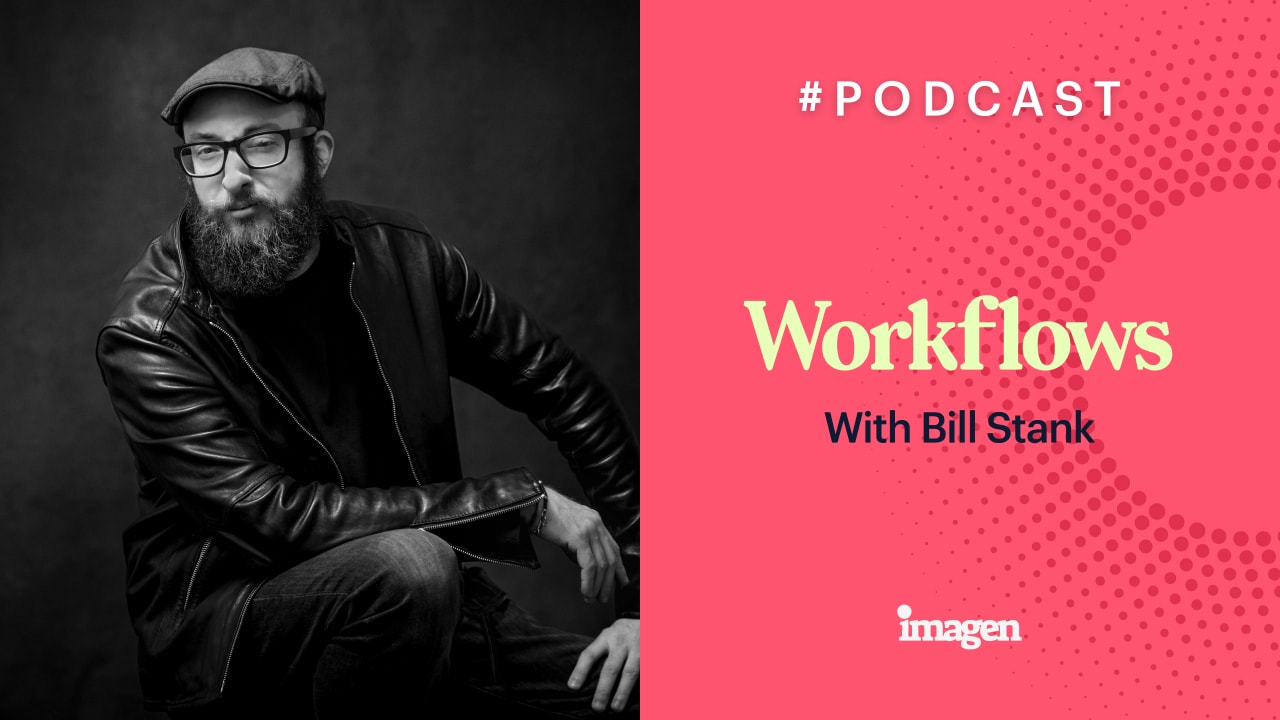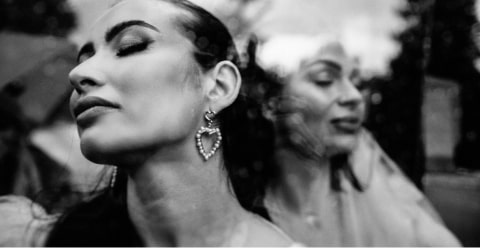Scott Wyden Kivowitz: Well, today I’ve got a very special episode for you. It is a fantastic talk from Bill Stank. He’s an award-winning wedding [00:01:00] photographer based out of Baltimore, Maryland, and Lehigh Valley, Pennsylvania.
Scott Wyden Kivowitz: He has been photographing weddings since 2012 and is a self-proclaimed Tikka Messala enthusiast and lives with his partner three dogs. A cat and over 100 houseplants. Bill is a fantastic wedding photographer and photographer all around and is an expert in lighting. And today he’s going to talk about his off camera lighting misconceptions.
Scott Wyden Kivowitz: Now, why, why on the Workflows Photography Podcast would Bill be talking about that? Well, as you know, if you’ve been listening to this podcast, you know that we talk all the time about a variety of workflow things, including in camera, behind the camera, photography workflows and off camera lighting is part of that.
Scott Wyden Kivowitz: So I asked Bill to come on and share his insights and without further ado, here is Bill sharing his thoughts. [00:02:00] On off camera lighting misconceptions.
Bill’s Introduction and Topic Overview
—
Bill Stank: Hey everyone, I’m Bill with Photosynthesis. I am a wedding photographer based out of eastern Pennsylvania, uh, shooting in Pennsylvania, New York, New Jersey, and surrounding areas. Uh, today I’m talking with Imagen and with Scott, uh, about some common misconceptions about off camera flash. A lot of times, there is a lot of great education out there about off camera flash.
Bill Stank: But one thing I think people don’t talk about as much are some of the misconceptions that come with it. So, um, this is not a right or wrong kind of thing. This is just my experience that I like to share with people. And I hope it helps you with your off camera flash journey and just your photography journey in general.
Bill Stank: So, let’s go through it. I think there’s… For misconceptions in my head, at least right now, um, they might come and go, but right now I’m going to go over four misconceptions about off camera [00:03:00] flash.
Misconception 1: Off Camera Flash is Too Difficult
—
Bill Stank: The first one I think a lot of people have when they’re starting off or before they start off is, I can’t do this.
Bill Stank: Um, that’s a, that’s a big misconception. You certainly can. I remember when I first started photography. I didn’t use any off camera flash. I didn’t even use any on camera flash or bounce flash, and I don’t even think I used a reflector. Uh, I just used window light. Um, I was working in a restaurant, and, uh, the restaurant owned the entire building, and on the fourth floor, there was an old warehouse space, which was really cool, and it had really beautiful window light coming in. but I remember… You know, I’m like, well, how do I get some kind of directional or dimensional light when I’m shooting somewhere else? I can’t always shoot here. So I started to dive into off-camera flash, and at first it seemed like this is just not something I can do. However, practice certainly makes perfect.
Bill Stank: It’s something that you have to, uh, invest the time into. So how do you do that? You’ve got friends, [00:04:00] you’ve got family, you’ve got other human beings, you know, ask your, your, your significant other, uh, can I photograph you? I want to kind of play around with some, some off camera flash, some new lighting techniques for me.
Bill Stank: So you’ve got, you know, maybe a roommate, uh, anyone, any human being, you know, just practice with them, uh, because you want to get comfortable working with people before you’re working with a client. Now a lot of what I’m saying today applies to wedding photography, Because I’m a wedding photographer, but it could apply to if you have a portrait client or anything else.
Bill Stank: So practice, practice with people that you know that aren’t clients. And uh, honestly, I have already bought a mannequin at Michael’s, a mannequin head. I impaled it onto a light stand when I didn’t have any human beings to practice on. uh I have even taken it outside to a public location and people looked at me like I was crazy and I’m okay with that Because I wanted to know how would this look outside not just inside and [00:05:00] how would this affect You know, someone’s face, even though it was a mannequin, so practice on any subject matter, And do that before you kinda dive into a wedding day or a portrait session. so, uh, another misconception, uh, let’s see, oh before I move on. In terms of, you know I can’t do this try to make it simple for yourself and and usually what’s happening with off camera flashes you have give to exposures you have the exposure in your camera which is the ambient light of your environment and then you have the exposure with your off camera flesh and your darling in with your transmitter don’t try to do it all at once Even for someone with experience, that could be kind of a lot to take on.
Bill Stank: So, um, dial in your ambient exposure with your camera, just what the overall kind of scene looks like, and then keep that setting the way it is in camera and then use your, your transmitter on your off camera flash to dial in the power for your, uh, your light on your subject matter. Breaking it up that [00:06:00] way, thinking of one exposure at a time can certainly help.
Bill Stank: You kind of dive in and start to learn it. Okay.
Misconception 2: No Time for Off Camera Flash on Wedding Day
—
Bill Stank: So misconception number two, uh, on a wedding day, I don’t have time for this. Um, I’m gonna mess up all the pictures. Uh, anyone that has photographed a wedding knows that weddings are, you know, a lot to take on. They’re fast paced. You might not have a lot of time.
Bill Stank: Or maybe you had time and something has affected that time, whether hair and makeup is running behind, or there’s a wardrobe malfunction, or transportation, you know, any number of things that are no one’s fault, it just happens, because there’s a lot of moving parts on a wedding day. Uh, what I would recommend is, you do, at some point, just have to dive into it, you know.
Bill Stank: Uh, I still remember when I was a kid, going to the pool. I was afraid to jump off the high dive. Climbing up the ladder and, uh, you know, eventually, at some point, I just had to jump, uh, and then as soon as I did, it was less intimidating. So that’s what you have to do on a wedding day. However, with the preface [00:07:00] of, whatever way you feel comfortable shooting, available light, ambient light, if you’re using a reflector, whatever isn’t off camera flash that you’re comfortable with, shoot 95%, for example, of the portraits with the couple.
Bill Stank: Using a technique that you’re comfortable with, I said dive in, but that doesn’t mean dive in completely, dive in the last five percents, you know, so the last few minutes with the couple After you’ve gotten pictures. That you know you’re comfortable shooting, then you can start using some off-camera flash.
Bill Stank: And the worst case scenario is you mess up those pictures. The couple isn’t missing out on anything. Um, one very important thing is though, if you’re going to different locations and for example, the last location you shoot at is maybe a bridge on a venue, uh, property that the couple likes, don’t solely say, well, this is the last few minutes I’m gonna use off-camera flash here.
Bill Stank: Uh, make sure to still in that location use. available light whatever you feel comfortable with so that the couple doesn’t [00:08:00] say, oh, well, you know, I thought we were shooting on the bridge are there any pictures? Um, so make sure you have a backup. Spend the last few minutes, make sure you have a backup, uh, location Uh, in terms of, you know, what pictures you’re taking and, um, you know, worst case scenario, the pictures don’t come out well with off-camera flash, that’s okay because the couple will still have, you know, pictures that they love and, and they’re not missing out on anything, so you won’t mess up their wedding.
Bill Stank: You do have time, even if it’s one minute, two minutes and then you start building up from there, the more confidence you get. Alright, so next misconception. Um,
Misconception 3: Off Camera Flash Always Improves Photos
—
Bill Stank: once you start getting into off-camera flash and you’re more proficient with it, uh, misconception is that well. Off camera flash will always make everything better. that’s not true. Sometimes off camera flash is great, sometimes it’s not the best choice. And there’s pros and cons of using off camera flash and I’ll just kind of go through a few of them. So, pros of using off [00:09:00] camera flash. You have a lot more control of your lights. You can move your light one side, the other side of the couple, whoever you’re photographing, you can light people from behind, you can light a wall behind someone and not light your subject and create a silhouette, you can create a lot of different kinds of images that aren’t there Um I personally like a sense of light, a dimension, a direction, and light and shadow So I know some photographers like to shoot on days that are overcast for me personally if I’m shooting outside and it’s overcast I would more likely use off camera flash because then it could feel like there’s some sunlight, some dimension of light So if you want to Add something that’s not there, add some creative control, that’s a really great thing, that’s a pro of off camera flash.
Bill Stank: Uh, some cons of off camera flash are, again, pertaining mostly to weddings, do you want to use flash during a ceremony? Do you [00:10:00] want to use a flash, uh, during a first look or something like that? for me personally, I try not to use flash during something that’s… Not portraits. Uh, I don’t want to intrude or interfere on what they’re doing.
Bill Stank: Um, now I could ask the couple, Hey, do you mind if I use flash during your ceremony? Uh, they could say, oh, sure. That’s fine. The only issue with that is they’re answering a question that they’ve never. Been in that specific circumstance before and until their ceremony starts, they don’t know how the flash is gonna affect them or not.
Bill Stank: Um, so whenever possible, I really try not to use flash in situations where it might be distracting or take away from a moment, from a first look from vows being exchanged, you know, something like that. Uh, another con is. Cash shadows. Um, anyone that has photographed abroad, especially in the last few years, I’m sure you’ve realized that tendrils have gotten more popular.
Bill Stank: Uh, sometimes the tendrils have gotten bigger, [00:11:00] too. Now, if you’re using off camera flash in the wrong way, a tendril… Uh, a light coming this way and a tendril can cast a shadow onto a bride’s face, uh, which wouldn’t be the most flattering thing, you know, for her. So, you have to be aware of cast shadows, and it’s not just tendrils.
Bill Stank: If you’re using off camera flash only for the dance party, if you have a six foot two groom standing next to a five foot bride, um, she might have a lot of cast shadows on her, and anyone that has photographed a dance party knows that when everyone is… Dancing drunk to Bon Jovi. Uh, there’s a lot of unpredictability and hands are being thrown around.
Bill Stank: So it’s, it’s not a situation where you have a lot of control. Um, now I’m not saying you can’t use off-camera flash, but there, there can be more risks of cash shadows and then not being able to see the great expressions that people have in that circumstance. Um, so. Pros and cons, always something to think about.
Bill Stank: Uh,
Misconception 4: Not Using Off Camera Flash Means You’re Not a Professional
—
Bill Stank: and then the last misconception is, if I don’t use off camera flash [00:12:00] enough or all the time, then I’m not a professional. or if you’re using natural and available light that means you don’t know how to use off camera flash but that’s definitely not true at all some of the best photographers out there and photographers that I look up to Pretty much only use natural light or available light and I’ve also seen them use off camera flash sometimes And they’re certainly very Proficient in it But for whatever reason Um, Whether it’s style or approach or just the, I know for me that the satisfaction of Finding a great little sliver of natural light that might be gone in two minutes because the clouds are coming That’s exciting to me to get that picture Because it’s fleeting.
Bill Stank: If I can capture that picture get a great image using that little spotlight of sunlight especially where I am it’s the fall right now and there’s beautiful low sunlight later in the day and it’s, there’s just something really special about that. If I can use that and, and take a picture, for me personally as a [00:13:00] photographer I feel, kind of more accomplished, as compared to if I use off camera flash because I have so much control of it.
Bill Stank: I can put it anywhere at any time. So, just because someone’s not using off camera flash doesn’t mean they don’t know how to. Um, they might purposely not want to and maybe they enjoy Searching and finding the lights and, um, off-camera flash can also, especially if you’re taking a wider shot, you can only light so much of the scene.
Bill Stank: Um, I guess in theory, if you have a, you know, 35 strobes set up off camera. A whole trim, set up like a Hollywood film. You can light an entire scene, but you can’t really do that realistically on a wedding day. So ah, if your kinda looking for that beautiful cascading light, cast shadows from trees in this little spot light going onto your subject, you know, it’s not something you can accomplish with Flash.
Bill Stank: So ah, [00:14:00] those are my.
Conclusion and Final Thoughts
—
Bill Stank: and kind of helps you on your journey with off camera flash if you’re just starting off or or if you’ve been using it for awhile and are kind of wondering well where else can I go don’t forget to embrace the the light that’s there because it might be really beautiful and one little quick notes when I first got into off camera Flash And after I was using it for a couple years, I kind of like to say I, I kind of blinded myself with my flash, and that’s all I was using, and I was kind of missing out on really beautiful opportunities that might have been there with lights, uh, and now, I don’t consider myself to be an off camera flash photographer, or a natural light photographer, or anything, I, I, I’m just a photographer.
Bill Stank: And, um, I, I want to keep all options open, and, uh, use the light that’s there, Add light that’s not there and, and, you know, really just, uh, you know, cover all my bases and, and not ever stick to just one kind of philosophy [00:15:00] of lighting. So I hope that helps. Um, I hope you have a great rest of your season and happy shooting to you all.
Bill Stank: Take care.
Host’s Closing Remarks
—
Scott Wyden Kivowitz: Thank you, Bill, so much for that incredible talk. I know there are countless takeaways for all the listeners about off camera lighting and these misconceptions, what they should do. Very actionable advice that you have provided. So thank you for joining me and sharing your thoughts with all the listeners.


